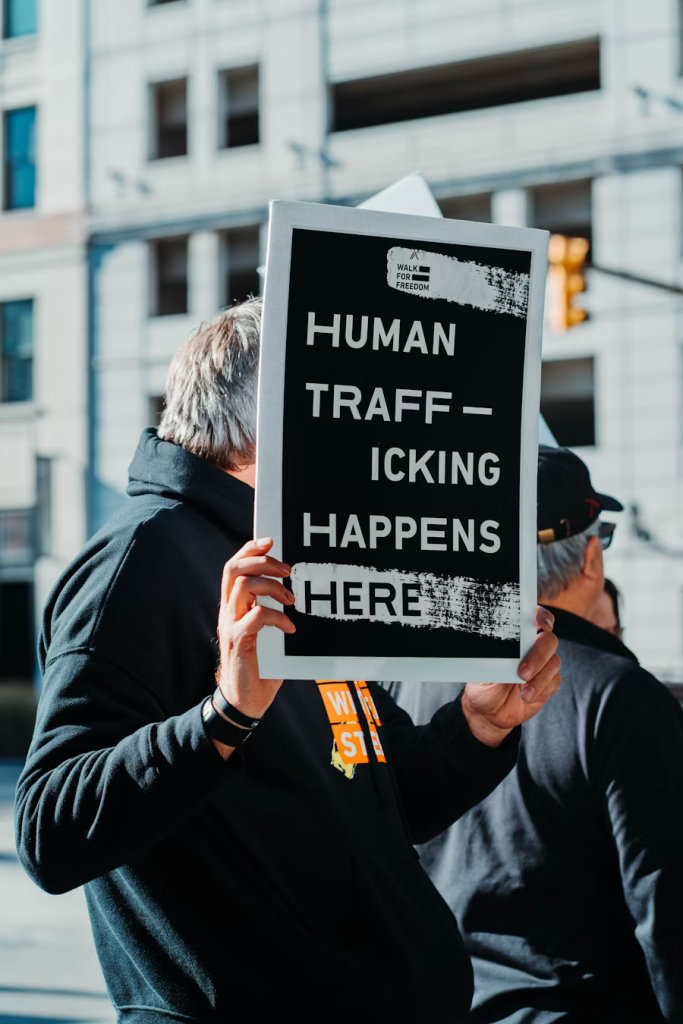Bias in the Identification of Victims of Human Trafficking in the European Union
Written by Elisa Garbil – 21.11.2025
Human trafficking remains one of the most pressing human rights and security challenges in the European Union. Despite decades of legislation and anti-trafficking initiatives, significant gaps persist in the identification and assistance of victims. Statistical evidence from 2017 to 2018 demonstrates a disproportionate focus on female victims of sexual exploitation, leaving male victims and those subjected to labour or other forms of exploitation largely unrecognised. This selective identification not only undermines the effectiveness of anti-trafficking programs but also exposes governments and civil society actors to substantial operational, legal, and reputational risks. Listen to Ludmila Bogdan to find out more!
The identification of victims is the cornerstone of any effective anti-trafficking strategy. Without accurate and comprehensive identification, victims cannot access protection, social support, legal remedies, or opportunities for reintegration. In the EU, countries serve as origins, transit points, and destinations for trafficked individuals, creating a complex landscape for identification efforts.
Evidence indicates that these efforts are heavily biased toward female victims of sexual exploitation, while male victims and those subjected to forced labour, domestic servitude, or other forms of exploitation remain largely invisible. This imbalance creates multiple risks: human rights violations, inefficient allocation of resources, diminished trust in authorities, and incomplete data for policymaking. Addressing these risks requires a nuanced, risk-based approach to victim identification that accounts for diverse forms of exploitation and demographic profiles.
The Current Landscape of Human Trafficking in the EU
Data from the EU-27 for 2017-2018 shows that sexual exploitation accounted for 60% of identified trafficking cases, while labour exploitation and other forms, including domestic servitude, begging, and forced criminal activity, represented only 15% each. An additional 10% of cases involved unidentified forms of exploitation.
The distribution of victims varies significantly across member states. Hungary, Estonia, and Slovenia report the highest proportion of sex trafficking cases, whereas Malta, Portugal, and Belgium show a predominance of labour trafficking. These discrepancies likely reflect differences in identification mechanisms and programmatic focus, rather than actual prevalence.
Gendered trends are equally striking. Across the EU, women constituted 72% of identified victims, while men made up 23%. Sexual exploitation overwhelmingly affects women (92% of cases), whereas men dominate labour trafficking cases (68%). This data suggests a systemic bias: identification mechanisms are disproportionately tuned to detect female victims of sexual exploitation while underrepresenting male victims and those trafficked for labour.

Structural Drivers of Identification Bias
Operational constraints contribute heavily to biased identification. Labour trafficking in sectors such as agriculture, construction, and hospitality often goes unnoticed due to limited labour inspections and inadequate operational capacity. Weak coordination among police, labour inspectors, border authorities, and NGOs further fragments identification efforts, leaving many victims unrecognised. In addition, different institutions record victim data inconsistently. Some maintain only officially identified victims, while others include presumed victims (i.e. individuals who meet the criteria but have not been formally recognised). This fragmentation results in a partial, often misleading representation of trafficking patterns, particularly for male victims and non-sexual forms of exploitation. Although EU Member States have ratified international protocols, including the Palermo Protocol, national laws often remain narrowly focused on sexual exploitation. Ambiguities in defining trafficking, particularly regarding irregular employment, leave many victims without legal recognition. Without clear guidelines, authorities may struggle to identify and assist individuals who fall outside stereotypical victim profiles.
Moreover, stereotypes profoundly influence identification outcomes. Common misconceptions include the belief that only women are trafficked, that victims are always foreign, and that trafficking always involves organised crime. These assumptions are embedded in training materials, national legislation, and media narratives, creating a cycle in which identification programs reinforce societal biases. Early awareness campaigns further entrenched these perceptions by sensationalising the sexual exploitation of women. Although recent efforts have sought to broaden the narrative to include men and victims of labour exploitation, the impact remains limited due to lower budgets, less visibility, and the challenge of counteracting decades of ingrained stereotypes.
Risks Stemming from Identification Bias
When identification is biased, the resources are often misallocated. Programs designed to combat trafficking may overemphasise sexual exploitation, while labour trafficking and other forms remain under-addressed. This misalignment reduces operational effectiveness and impedes evidence-based policymaking according to Ludmila Bogdan. This failure to identify all victims constitutes a breach of human rights obligations. Unidentified victims are denied protection, support, and access to justice. National authorities risk violating EU and international standards, with potential legal and reputational consequences.
Bias in identification undermines public confidence and discourages victims from seeking help. Male victims, in particular, may not recognise themselves as victims due to the dominant female-focused imagery of trafficking. Similarly, victims of labour exploitation often perceive authorities as irrelevant to their plight, further reducing cooperation.

Policy Recommendations for Risk Mitigation
According to Ludmila Bogdan a risk-based approach to victim identification should address operational, legal, and societal drivers of bias:
- Strengthen Operational Capacity: Expanding labour inspections and monitoring in high-risk sectors, increasing staffing, and improving inter-agency coordination are critical steps. Frontline officers must be equipped with training and tools to recognise diverse victim profiles, including male victims and those trafficked for labour or forced criminal activities.
- Standardise Data Collection: Harmonising victim definitions across institutions and including both identified and presumed victims can provide a more accurate picture of trafficking dynamics. Data analytics should be applied to detect patterns and anticipate emerging risks.
- Reform Legal Frameworks: National laws must explicitly cover all forms of trafficking. Clear guidelines for interpreting cases of irregular employment are essential to prevent exclusion of certain victim categories. Policymakers should develop practical tools to ensure consistent application of laws and to support uniform enforcement.
- Challenge Societal Stereotypes: Re-educating the public, media, and anti-trafficking practitioners about diverse victim profiles is essential. Awareness campaigns should feature empowered survivors, both men and women, rather than relying on sensationalist or fear-based imagery. Collaborating with journalists and media organisations to promote accurate, inclusive reporting can help shift public perception.
- Tailor Information Campaigns: Localised campaigns that address specific sectors and communities can enhance identification outcomes. Monitoring public perception through surveys and focus groups allows authorities to evaluate the impact of campaigns and adapt strategies accordingly.
- Adopt Survivor-Centered Approaches: Survivor-centered practices encourage victims to self-identify and seek help. Building trust through empathetic engagement and highlighting recovery stories can improve cooperation and reduce barriers to identification.
Conclusion
Despite notable progress in combating human trafficking, biases in victim identification persist, leaving male victims and those subjected to labour exploitation underrepresented. These gaps pose operational, legal, and reputational risks for EU Member States and weaken the overall effectiveness of anti-trafficking strategies.
A risk-based approach requires recognising the diversity of trafficking forms, strengthening operational and legal mechanisms, and challenging entrenched societal stereotypes. By empowering survivors and providing inclusive, accurate awareness campaigns, EU and other State authorities can improve identification outcomes, enhance public trust, and ensure comprehensive protection for all victims of human trafficking.



